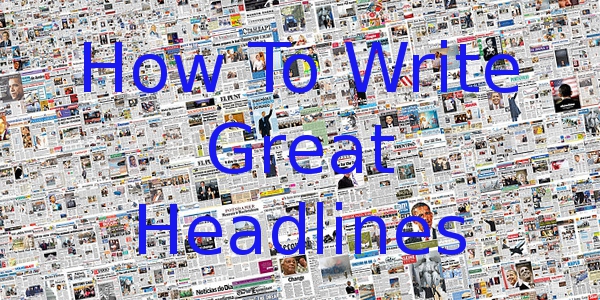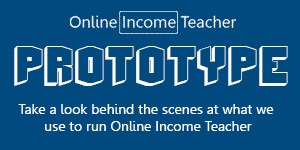
The most important part of your website is its content, and the most important part of your content is the headline! This means that your content headlines are THE most important part of your entire website!!!
Your headline is the first, and perhaps the only, thing that will grab the attention of your readers. This makes it vitally important that you make it count and use a great one to make the biggest impression!
One of our most popular articles was ‘10 Steps to Write Amazing Content!‘ where we stressed that ‘Content is King‘ when it comes to your website. Without good website content, you will never get any interest in your website. The headline is the primary way of doing this, as it is headlines that draws people in.
But headlines can do a lot more than just attract people’s attention. A great headline can convey a lot of information, telling your targeted audience exactly what your article is about, whilst luring them in to read it.
You only have to look at newspapers to see the value that headlines have. The front page headline is the most important part, as it is this that usually influences people whether to buy the paper or not.
Many people underestimate the importance that their blog post titles have. You can write an amazing article post that people would find really helpful, but give it a bad headline title and nobody will read it. This inspired me to write this post to help you to write great headlines that work for your website.
How to Write a Great Headline
Headline writing can be a bit of an art form. The more experience you have, the better you get at doing it. There are a few things that you can ask yourself to see whether your headline is a good one, sort of like a check list.
Is your headline useful? – If people reading it can see that they can get some use out of it, perhaps learning something from it, then they will be more likely to read it.
Is your headline informative? – You should know exactly what the following article will be about from the headline alone. If not, then people will not read it because they won’t know what it is about.
Is your headline unique? – This can be harder depending on the subject matter. If there are lots of articles on a similar subject, then you need it to stand out from the rest in some way.
Spend Time Writing Your Headline
Due to the importance of your headline title, there is no need to rush in and commit to one. I know other bloggers that spend as long coming up with that right headline as they do writing their blog post.
I usually write a very rough blog title right at the start of writing a post. That way I can determine the direction that I want to go in when writing my post. I then come back when I have finished my entire article and write a much better one. Sometimes this is much easier than some posts, and I have been known to change a blog post title a week later because I am just not happy with it.
Ultimately, it doesn’t matter how you come up with your headline. As long as you put some thought into it and it is clear to your audience, then that is a good headline.
80% Of People Will Read Your Headlines
On average, a massive 80% of all people that come across your headline will read it! That is a huge percentage of people, however only 20% end up reading the article. That is a big difference!
This helps to display how important the headline is. If you spend time writing a great headline, then that could increase the amount of people that go on to read your article.
Different Types of Headline
There are many different types of headline that you can use to present your articles. The following are some of the most common types;
‘How to…’ Headline – These can make great headlines. Everyone wants to learn something new, so there is high demand for articles that show then ‘how to’ do this. This very article that you are reading is a ‘how to’ article, so it worked with you!
‘Direct’ Headlines – A direct headline is one that doesn’t mess about, it gets straight to the point. This can work well for promotions and offers, for example, ‘25% Off Web Hosting‘ or ‘FREE Website eCourse‘.
‘Indirect’ Headlines – This type of headline is the opposite to the ‘direct’ method. An ‘Indirect’ headline takes a craftier approach. Often these types of headlines are written in such a way that readers are curious about what the article is about. An example of this would be, ‘You are slowly killing yourself’ in reference to a post about bad health habits. ‘Top List’ Headlines – This type of headline is one of my favourites. Everybody likes lists of things, whether it’s ‘Top 10 Football Clubs’, ‘5 Great Ways to Save Money’, ‘30 Ways Your Website Can Earn You Money‘, etc. People find lists easy to follow because they are split up into a set number of points.
‘Question’ Headlines – Fairly self-explanatory, a ‘question’ headline asks a question to your audience. For example, ‘Is Nuclear Energy Worth The Risk?’, ‘Does Britain Still Need The Royal Family?’, etc. These questions need to involve the audience, so either they want to know what you have to say in response to the question posed, or have an opinion of their own which they what to see if they agree with the article.
‘Command’ Headlines – Offering a ‘command’ to your readers can also work. Something like ‘Get Started Today!’* or ‘Change Your Life Now!’ can have an impact on your readers.
‘Testimonial’ Headlines – These types of headline can be very successful when promoting yourself or your own product. ‘”Why I Love OnlineIncomeTeacher.com” – by Scarlett Johansson’ (I wish!). This type of headline can give your readers an outside perspective that they might find interesting.
News Headlines – This type of headline can also work, if the news is still relevant. Writing a post about the Royal Wedding might have proved popular around the time of the event when there was a lot of interest. Writing one now would not be as interesting.

CommentLuv vs Disqus – Why I Don’t Use CommentLuv!